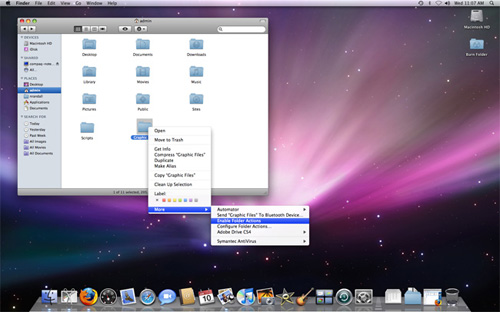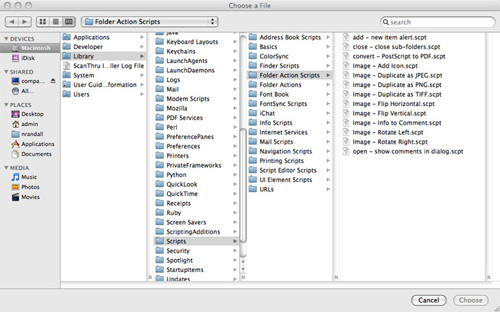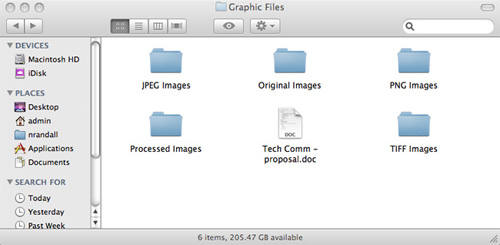Introducing Folder Action in Mac OS X
TipsMake.com - If you often have to perform repetitive tasks in the folder of Mac OS X operating system, you can create scripts to automate those operations. The following article will introduce Folder Action in Mac OS X.
Automation technology is programmed to integrate into OS X operating system as AppleScript scripting language. As its name suggests, AppleScript is a scripting user interface - small programs can run separately or in combination with other scripts or macros. One of the very useful things you can do with AppleScript is to create Folder Actions, allowing you to automatically perform operations in the folder.
Folder Action has a very simple purpose: apply script-based operations to things that are added or removed from the folder. For example, if you have some image files in TIFF format, you need to resize them, change them all to gray scale, switch to PNG format and save. Graphics software like Photoshop can help you do that. But if those files are scattered all over your Mac, it would be much more convenient to just drag them to a separate folder that the change process was done automatically. With Folder Action, you won't need to open the additional programs needed to make changes.
Of course, Folder Action scripts don't need to be so complicated. If you intend to try writing a Folder Action from scratch, you should not try to create a script that is too troublesome. In fact, Mac OS X has a number of Folder Action scripts available and all are relatively simple. Here is a list of six of them:
add - new item alert.scpt A pop-up window appears to let you know a file has been added to the folder. This scenario is obviously very useful for shared folders that you need to track the content in.
close - close sub-folders.scpt Designed to clean the screen. Every time a file is added to the folder, that folder and all subdirectories will automatically close.
convert - PostScript to PDF.scpt This script converts PostScript files to PDF format as soon as you add them to the folder.
image - Duplicate as JPEG.scpt When you add images to a folder, OS X will automatically create a copy for that image in JPEG format. If the image itself is in JPEG format, the script will do nothing. There are actually three scenarios of this type built into OS X: a script to convert to JPEG, a script to convert to PNG format, and finally a script to convert to TIFF format.
image - Rotate Left.scpt Any image file added to the folder is rotated 90 degrees to the left. There is another scenario similar to this scenario, but turning the image to the right and having two scenarios flip the image horizontally or vertically.
image - Info to Comment.scpt When you add an image file to the folder, the image file information will be added to the Spotlight comment field. There is a related script that allows you to automatically see these annotations whenever a new file is added to the folder.

Available Folder Action scripts are located in Macintosh HD -> Libraries -> Scripts -> Folder Action Scripts.
Obviously, these are not too great additions to your automation. But they show the power of Folder Actions, especially in case you have multiple files to apply. Once you put the script in place, simply manipulating the file from one folder to another can be activated for the operation scenario. You will feel very easy and convenient.
Folder Actions work when you attach specific scripts to specific folders. But first, please note that the Folder Action system needs to be activated. You can do this in two main ways as follows:
- Right-click the folder, select More -> Enable Folder Actions
- Right-click the folder, select More -> Configure Folder Actions , and check Enable Folder Actions on the Folder Actions Setup dialog box.
Enabling Folder Action system will be effective all over OS X, not just any folder. In fact, even if you want, you can't activate Folder Action individually.

The drop-down menu points to the option Enable Folder Actions.After activating Folder Actions, you can disable it by returning to this menu.
Once you have Folder Actions enabled, you can tell OS X what you want the folder to do by assigning it a script. To select the scenario you want to apply to a specific folder, right-click the folder, choose More -> Attach a Folder Action . Normally you will see the Folder Actions Scripts folder . Otherwise go to Macintosh HD -> Libraries -> Scripts -> Folder Action Scripts .

You can see the scripts in the rightmost frame.If you have scripts created or downloaded from the web, you should put them in this folder for your convenience.
Each folder can contain multiple Folder Actions, so you are not restricted to doing only one thing with drag and drop. If your Mac has a speaker on, you can hear it every time the script is executed. In some cases, the script creates subdirectories (such as the file format conversion script available in OS X), open the root directory to see what the script did.

The Original Images subfolder contains graphic files that are dropped into the root directory.JPEG, PNG, and TIFF subfolders contain the corresponding copy that converted the format of those files.All these folders are created automatically by the script.
You should read it
- Macromedia Flash - Advanced masking with action script
- How to Enable and Use Script Execution Policy in Windows PowerShell
- How to create and run a shell script in Ubuntu 20.04 LTS
- How to create and run a PowerShell script file on Windows 10
- 4 Google Script makes Google Sheets more powerful
- Macromedia Flash - Making fireworks effects
- Macromedia Flash - Effects of changing position of text
- Managing Windows networks using Script - Part 9: Understanding remote scripting
May be interested
- Instructions to change folder color - Folder
 in a computer with a lot of folders, you want to distinguish the folders for different jobs for easy searching. folder highlight software can help you do that by changing the folder color so you can easily identify the folder.
in a computer with a lot of folders, you want to distinguish the folders for different jobs for easy searching. folder highlight software can help you do that by changing the folder color so you can easily identify the folder. - Action buttons in PowerPoint 2016
 action buttons are integrated shapes that users can add to presentations and place to link to another slide, play sounds or perform a similar action.
action buttons are integrated shapes that users can add to presentations and place to link to another slide, play sounds or perform a similar action. - Tips to change the default name of the newly created folder on Windows 10
 when you create a new folder in windows 10, the folder name will automatically be 'new folder'.
when you create a new folder in windows 10, the folder name will automatically be 'new folder'. - How to Zip Folder on Windows
 this wikihow teaches you how to create a zip file from a folder using either the built-in windows zip tool or a third-party app like winzip. navigate to the folder you want to zip. no need to open the folder, just bring it onto the screen....
this wikihow teaches you how to create a zip file from a folder using either the built-in windows zip tool or a third-party app like winzip. navigate to the folder you want to zip. no need to open the folder, just bring it onto the screen.... - What is WinSxS? How to clean the WinSxS folder on Windows 10
 the winsxs folder contains system repositories and is an important part of the windows environment. over time, this folder keeps expanding without any limit and can take up a lot of unnecessary space on the hard drive.
the winsxs folder contains system repositories and is an important part of the windows environment. over time, this folder keeps expanding without any limit and can take up a lot of unnecessary space on the hard drive. - This is how to customize and disable (turn off) Action Center on Windows 10
 the action center feature in windows 10 is not loved by many users because they take time and effort to delete these notifications on the screen. if you are a windows 10 user and you want to disable the action center feature in windows 10, you can refer to the following article of network administrator.
the action center feature in windows 10 is not loved by many users because they take time and effort to delete these notifications on the screen. if you are a windows 10 user and you want to disable the action center feature in windows 10, you can refer to the following article of network administrator. - How to edit the Action Center quick button on Windows 10 19H1
 microsoft has taken action center and quick action button (quick toggle) from windows phone to desktop platform. here's how to edit quick action buttons on action center on windows 10 19h1.
microsoft has taken action center and quick action button (quick toggle) from windows phone to desktop platform. here's how to edit quick action buttons on action center on windows 10 19h1. - How to navigate folders in Windows Command Prompt
 when you want to modify the properties of a specific file, scan a specific folder, or perform any other action in command prompt, you must first navigate to that folder.
when you want to modify the properties of a specific file, scan a specific folder, or perform any other action in command prompt, you must first navigate to that folder. - How to protect folders with Secure Folder?
 in the process of using the computer, you will have important folders and files that need to be kept secret, avoiding the curiosity of others when they use the device. therefore, the solution here is to use security software. there are many different but popular, easy-to-use security software, including subisoft secure folder. with it, you can lock, hide or encrypt the entire folder.
in the process of using the computer, you will have important folders and files that need to be kept secret, avoiding the curiosity of others when they use the device. therefore, the solution here is to use security software. there are many different but popular, easy-to-use security software, including subisoft secure folder. with it, you can lock, hide or encrypt the entire folder. - How to Make a New Folder on a Computer
 this wikihow teaches you how to create a new, empty folder on both windows and mac computers. go to the area where you want to create the folder. the easiest example is your computer's desktop, but you can create a folder anywhere on your...
this wikihow teaches you how to create a new, empty folder on both windows and mac computers. go to the area where you want to create the folder. the easiest example is your computer's desktop, but you can create a folder anywhere on your...










 Use new Exposé features in Snow Leopard
Use new Exposé features in Snow Leopard 5 interesting functions of spacebar
5 interesting functions of spacebar 10 features Apple imitates from Windows
10 features Apple imitates from Windows Use Mac OS X to create Wifi Hotspot
Use Mac OS X to create Wifi Hotspot Improve efficiency with Services in Mac 10.6
Improve efficiency with Services in Mac 10.6 Work efficiently on Mac with Active Screen Corners
Work efficiently on Mac with Active Screen Corners